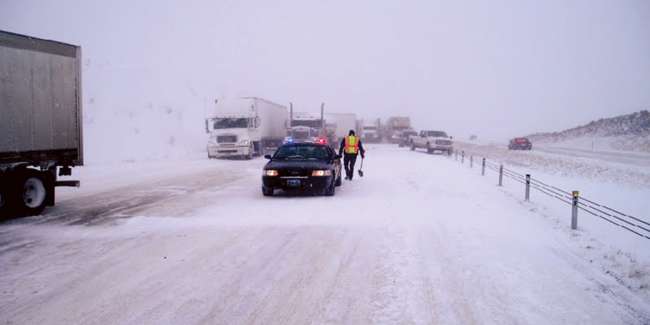Staff Reporter
Wyoming Plans to Test Connected Vehicle Technology on Trucks

The Wyoming Department of Transportation is preparing to test connected vehicle technology in trucks and government vehicles along Interstate 80 to reduce the number of accidents that occur during the state’s treacherous winter months.
The interstate, which stretches across Wyoming for 402 miles, is an important yet dangerous artery for freight transportation. According to WYDOT, crash rates on the state’s portion of I-80 are three to five times more likely in the winter due to conditions that hinder visibility, such as blowing snow. The route was subject to 18 fatalities in 2016 alone, according to WYDOT.
This winter, snowplows and highway patrol vehicles registered with WYDOT will take part in testing connected vehicle technology. Some 400 commercial trucks will be outfitted with the same technology as the maintenance vehicles during the winter of 2018.

Ragan
“There’s a real need for improved safety on the I-80 corridor through Wyoming. There’s some very harsh winter conditions, particularly from strong winds,” said Ali Ragan, communications officer for WYDOT. “Any commercial vehicle driver who’s spent any time in Wyoming knows about the danger of driving in these conditions. Sometimes it results in some very big crashes with a high number of vehicles. We know that we’re not going to be able to stop every crash from happening with this technology, but we do hope to reduce the numbers.”
Despite the hazardous climate, southern Wyoming is a major east-west truck corridor. According to WYDOT, I-80’s annual average daily truck traffic ranges from 4,000 to 6,700 trucks. To mitigate accidents, WYDOT is testing connected vehicle technology that allows trucks to communicate with roadside outposts and each other.
According to Ragan, 75 roadside units along I-80 will be furnished with Dedicated Short Range Communication radios, which will connect to their on-board unit counterparts that will be installed in trucks.
As a test of vehicle-to-vehicle connectivity, these onboard units will broadcast other connected vehicles’ speed, location and heading 10 times a second, Ragan said. Applications run on Android devices in the trucks collect information from the DSRC radios and alert drivers about other vehicles and road conditions.
“It’s a way to give drivers early warnings about things they can’t see, like blowing snow and fog conditions,” Ragan said. “If there’s a crash at the bottom of the hill, the drivers can be alerted before they crest the hill.”
In addition to vehicles that communicate with one another, WYDOT’s pilot program will also test vehicle-to-infrastructure connectivity. Vehicle-to-infrastructure communication refers to information broadcast from the roadside units to the connected vehicles. Ragan said this type of connectivity involves situational awareness applications that include information on weather alerts, road closures, vehicle restrictions, crashes and parking.
WYDOT’s pilot is part of a 2015 U.S. DOT grant that divided $45 million among New York City, Tampa, Fla., and Wyoming. After a one-year planning period, the three recipients are preparing to deploy and test the connected vehicle technology.
Our members were very positive about [the test]. We’ve been trying to provide WYDOT with as many sources as possible.
Sheila Foertsch
WYDOT is still looking for partners to fill the spots for the 400 vehicles that will test this technology.
Wyoming’s Trucking Association issued a notice to its members and connected WYDOT with its counterparts in Utah and Nevada, according to Wyoming Trucking Association Managing Director Sheila Foertsch.
Foertsch said several of her association’s members immediately expressed interest in the project. She said WYDOT has made several presentations to the state’s trucking association to assuage any trepidation prospective participants may have about the program.
“Our members were very positive about it. We’ve been trying to provide WYDOT with as many sources as possible,” Foertsch said. “The more carriers that participate, the better the information’s going to be.”
The state is purchasing DSRC radios and Android tablets for truck drivers who use Apple products, Ragan said. When the 2018-2019 pilot period is over, trucks can keep the technology and continue using it.
“We want to make sure it works in our environment and that it results in a safety benefit,” said Vince Garcia, geographic information systems program manager at WYDOT. “It’s a tough route.”





